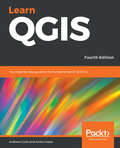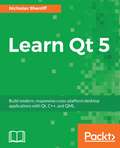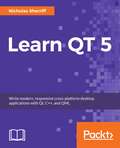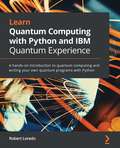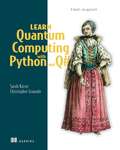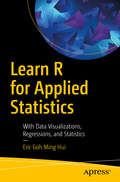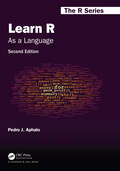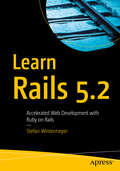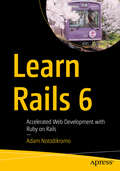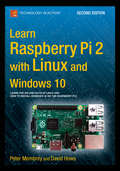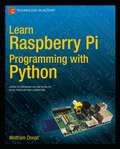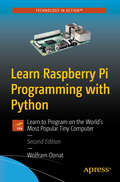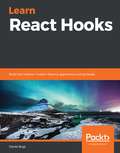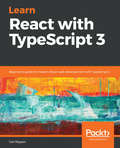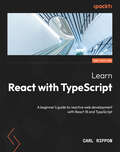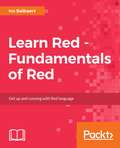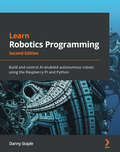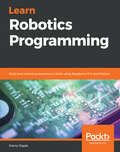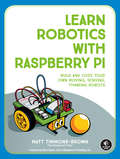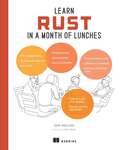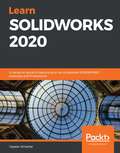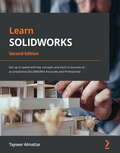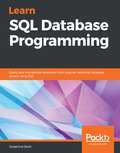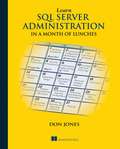- Table View
- List View
Learn QGIS: Your step-by-step guide to the fundamental of QGIS 3.4, 4th Edition
by Anita Graser Andrew CuttsLearn to view, edit and analyse geospatial data using QGIS and Python 3 Key Features *Leverage the power of QGIS to add professionalism to your maps *Explore and work with the newly released features like Python 3, GeoPackage, 3D views, Print layouts in QGIS 3.4 *Build your own plugins and customize maps using QT designer Book Description QGIS 3.4 is the first LTR (long term release) of QGIS version 3. This is a giant leap forward for the project with tons of new features and impactful changes. Learn QGIS is fully updated for QGIS 3.4, covering its processing engine update, Python 3 de-facto coding environment, and the GeoPackage format. This book will help you get started on your QGIS journey, guiding you to develop your own processing pathway. You will explore the user interface, loading your data, editing, and then creating data. QGIS often surprises new users with its mapping capabilities; you will discover how easily you can style and create your first map. But that's not all! In the final part of the book, you'll learn about spatial analysis and the powerful tools in QGIS, and conclude by looking at Python processing options. By the end of the book, you will have become proficient in geospatial analysis using QGIS and Python. What you will learn *Explore various ways to load data into QGIS *Understand how to style data and present it in a map *Create maps and explore ways to expand them *Get acquainted with the new processing toolbox in QGIS 3.4 *Manipulate your geospatial data and gain quality insights *Understand how to customize QGIS 3.4 *Work with QGIS 3.4 in 3D Who this book is for If you are a developer or consultant familiar with the basic functions and processes of GIS and want to learn how to use QGIS to analyze geospatial data and create rich mapping applications, this book is for you. You'll also find this book useful if you're new to QGIS and wish to grasp its fundamentals
Learn Qt 5: Build Modern, Responsive Cross-platform Desktop Applications With Qt, C++, And Qml
by Nicholas SherriffQt is a mature and powerful framework for delivering sophisticated applications across a multitude of platforms. It has a rich history in the Linux world, is widely used in embedded devices and has made great strides in the Mobile arena over the past few years. However, in the Microsoft Windows and Apple Mac OS X worlds, the dominance of C#/.NET and Objective-C/Cocoa mean that Qt is often overlooked.) solution from scratch, with distinct library, user interface and unit test projects.
Learn Qt 5: Build modern, responsive cross-platform desktop applications with Qt, C++, and QML
by Nicholas SherriffLearn the fundamentals of QT 5 framework to develop interactive cross-platform applications Key Features A practical guide on the fundamentals of application development with QT 5 Learn to write scalable, robust and adaptable C++ code with QT Deploy your application on different platforms such as Windows, Mac OS, and Linux Book Description Qt is a mature and powerful framework for delivering sophisticated applications across a multitude of platforms. It has a rich history in the Linux world, is widely used in embedded devices, and has made great strides in the Mobile arena over the past few years. However, in the Microsoft Windows and Apple Mac OS X worlds, the dominance of C#/.NET and Objective-C/Cocoa means that Qt is often overlooked. This book demonstrates the power and flexibility of the Qt framework for desktop application development and shows how you can write your application once and deploy it to multiple operating systems. Build a complete real-world line of business (LOB) solution from scratch, with distinct C++ library, QML user interface, and QtTest-driven unit-test projects. This is a suite of essential techniques that cover the core requirements for most LOB applications and will empower you to progress from a blank page to shipped application. What you will learn · Install and configure the Qt Framework and Qt Creator IDE · Create a new multi-project solution from scratch and control every aspect of it with QMake · Implement a rich user interface with QML · Learn the fundamentals of QtTest and how to integrate unit testing · Build self-aware data entities that can serialize themselves to and from JSON · Manage data persistence with SQLite and CRUD operations · Reach out to the internet and consume an RSS feed · Produce application packages for distribution to other usersWho this book is for This book is for application developers who want a powerful and flexible framework to create modern, responsive applications on Microsoft Windows, Apple Mac OS X, and Linux desktop platforms. You should be comfortable with C++ but no prior knowledge of Qt or QML is required.
Learn Quantum Computing with Python and IBM Quantum Experience: A hands-on introduction to quantum computing and writing your own quantum programs with Python
by Robert LoredoA step-by-step guide to learning the implementation and associated methodologies in quantum computing with the help of the IBM Quantum Experience, Qiskit, and Python that will have you up and running and productive in no time Key Features Determine the difference between classical computers and quantum computers Understand the quantum computational principles such as superposition and entanglement and how they are leveraged on IBM Quantum Experience systems Run your own quantum experiments and applications by integrating with Qiskit Book Description IBM Quantum Experience is a platform that enables developers to learn the basics of quantum computing by allowing them to run experiments on a quantum computing simulator and a real quantum computer. This book will explain the basic principles of quantum mechanics, the principles involved in quantum computing, and the implementation of quantum algorithms and experiments on IBM's quantum processors. You will start working with simple programs that illustrate quantum computing principles and slowly work your way up to more complex programs and algorithms that leverage quantum computing. As you build on your knowledge, you'll understand the functionality of IBM Quantum Experience and the various resources it offers. Furthermore, you'll not only learn the differences between the various quantum computers but also the various simulators available. Later, you'll explore the basics of quantum computing, quantum volume, and a few basic algorithms, all while optimally using the resources available on IBM Quantum Experience. By the end of this book, you'll learn how to build quantum programs on your own and have gained practical quantum computing skills that you can apply to your business. What you will learn Explore quantum computational principles such as superposition and quantum entanglement Become familiar with the contents and layout of the IBM Quantum Experience Understand quantum gates and how they operate on qubits Discover the quantum information science kit and its elements such as Terra and Aer Get to grips with quantum algorithms such as Bell State, Deutsch-Jozsa, Grover's algorithm, and Shor's algorithm How to create and visualize a quantum circuit Who this book is for This book is for Python developers who are looking to learn quantum computing and put their knowledge to use in practical situations with the help of IBM Quantum Experience. Some background in computer science and high-school-level physics and math is required.
Learn Quantum Computing with Python and IBM Quantum: Write your own practical quantum programs with Python
by Robert LoredoA step-by-step guide to working with programs that exploit quantum computing principles, with the help of IBM Quantum, Qiskit, and PythonKey FeaturesGet familiar with the features within the IBM Quantum PlatformCreate and visualize quantum gates and circuitsOperate quantum gates on qubits using the IBM Quantum ComposerInstall and run your quantum circuits on an IBM Quantum computerDiscover Qiskit and its many features such as the Qiskit RuntimeBook DescriptionThe IBM Quantum Platform was built to enable developers to learn the basics of quantum computing by providing access to high performant quantum computers and provide documentation and courses to help get up to speed with the latest features in quantum computing. Updated with new examples and changes to the platform, this edition begins with an introduction to the IBM Quantum Platform and the Quantum Information Science Kit (Qiskit) SDK. You will become well versed in the IBM Quantum Composer interface as well as running your quantum circuits on a real quantum computer. Along the way, you’ll learn some of the fundamental principles regarding quantum mechanics, qubits, quantum gates, quantum circuits, and the error mitigation techniques that are used to perform operations on qubits. As you build on your knowledge, you’ll understand the functionality of IBM Qiskit and the developer-focused resources so you can create your own quantum algorithms. You’ll learn how to monitor and optimize your quantum circuits. Lastly, you’ll look at the fundamental quantum algorithms and understand how they can be applied effectively. By the end of this quantum computing book, you'll know how to build quantum algorithms and will have gained a practical understanding of quantum computation that you can apply to your research or business. What you will learnGet familiar with the features within the IBM Quantum Platform Create and visualize quantum gates and circuits Operate quantum gates on qubits using the IBM Quantum Composer Install and run your quantum circuits on an IBM Quantum computer Discover Qiskit and its many features such as the Qiskit Runtime Get to grips with fundamental quantum algorithms and error mitigation techniques to help you get started Understand the new era of quantum utility and how this moves us closer towards quantum advantage Who this book is forThis book is for Python developers who are looking to learn quantum computing from the ground up and put their knowledge to use in practical situations with the help of the IBM Quantum Platform and Qiskit. Some background in computer science and high school-level physics and math is required.
Learn Quantum Computing with Python and Q#: A hands-on approach
by Sarah C. Kaiser Christopher GrenadeLearn Quantum Computing with Python and Q# introduces quantum computing from a practical perspective.Summary Learn Quantum Computing with Python and Q# demystifies quantum computing. Using Python and the new quantum programming language Q#, you&’ll build your own quantum simulator and apply quantum programming techniques to real-world examples including cryptography and chemical analysis. Purchase of the print book includes a free eBook in PDF, Kindle, and ePub formats from Manning Publications. About the technology Quantum computers present a radical leap in speed and computing power. Improved scientific simulations and new frontiers in cryptography that are impossible with classical computing may soon be in reach. Microsoft&’s Quantum Development Kit and the Q# language give you the tools to experiment with quantum computing without knowing advanced math or theoretical physics. About the book Learn Quantum Computing with Python and Q# introduces quantum computing from a practical perspective. Use Python to build your own quantum simulator and take advantage of Microsoft&’s open source tools to fine-tune quantum algorithms. The authors explain complex math and theory through stories, visuals, and games. You&’ll learn to apply quantum to real-world applications, such as sending secret messages and solving chemistry problems. What's inside The underlying mechanics of quantum computers Simulating qubits in Python Exploring quantum algorithms with Q# Applying quantum computing to chemistry, arithmetic, and data About the reader For software developers. No prior experience with quantum computing required. About the author Dr. Sarah Kaiser works at the Unitary Fund, a non-profit organization supporting the quantum open-source ecosystem, and is an expert in building quantum tech in the lab. Dr. Christopher Granade works in the Quantum Systems group at Microsoft, and is an expert in characterizing quantum devices. Table of Contents PART 1 GETTING STARTED WITH QUANTUM 1 Introducing quantum computing 2 Qubits: The building blocks 3 Sharing secrets with quantum key distribution 4 Nonlocal games: Working with multiple qubits 5 Nonlocal games: Implementing a multi-qubit simulator 6 Teleportation and entanglement: Moving quantum data around PART 2 PROGRAMMING QUANTUM ALGORITHMS IN Q# 7 Changing the odds: An introduction to Q# 8 What is a quantum algorithm? 9 Quantum sensing: It&’s not just a phase PART 3 APPLIED QUANTUM COMPUTING 10 Solving chemistry problems with quantum computers 11 Searching with quantum computers 12 Arithmetic with quantum computers
Learn R for Applied Statistics: With Data Visualizations, Regressions, and Statistics
by Eric Goh HuiGain the R programming language fundamentals for doing the applied statistics useful for data exploration and analysis in data science and data mining. This book covers topics ranging from R syntax basics, descriptive statistics, and data visualizations to inferential statistics and regressions. After learning R’s syntax, you will work through data visualizations such as histograms and boxplot charting, descriptive statistics, and inferential statistics such as t-test, chi-square test, ANOVA, non-parametric test, and linear regressions. Learn R for Applied Statistics is a timely skills-migration book that equips you with the R programming fundamentals and introduces you to applied statistics for data explorations. What You Will LearnDiscover R, statistics, data science, data mining, and big dataMaster the fundamentals of R programming, including variables and arithmetic, vectors, lists, data frames, conditional statements, loops, and functionsWork with descriptive statistics Create data visualizations, including bar charts, line charts, scatter plots, boxplots, histograms, and scatterplotsUse inferential statistics including t-tests, chi-square tests, ANOVA, non-parametric tests, linear regressions, and multiple linear regressionsWho This Book Is ForThose who are interested in data science, in particular data exploration using applied statistics, and the use of R programming for data visualizations.
Learn R: As a Language (Chapman & Hall/CRC The R Series)
by Pedro J. AphaloLearning a computer language like R can be either frustrating, fun or boring. Having fun requires challenges that wake up the learner’s curiosity but also provide an emotional reward for overcoming them. The book is designed so that it includes smaller and bigger challenges, in what I call playgrounds, in the hope that all readers will enjoy their path to R fluency. Fluency in the use of a language is a skill that is acquired through practice and exploration. For students and professionals in the biological sciences, humanities and many applied fields, recognizing the parallels between R and natural languages should help them feel at home with R. The approach I use is similar to that of a travel guide, encouraging exploration and describing the available alternatives and how to reach them. The intention is to guide the reader through the R landscape of 2024 and beyond.What is new in the second edition? Text expanded by more than 25% to include additional R features and gentler and more detailed explanations Contains 24 new diagrams and flowcharts, seven new tables, and revised text and code examples for clarity All three indexes were expanded, and answers to 28 frequently asked questions added What will you find in this book? Programming concepts explained as they apply to current R Emphasis on the role of abstractions in programming Few prescriptive rules—mostly the author’s preferences together with alternatives Presentation of the R language emphasizing the “R way of doing things” Tutoring for “programming in the small” using scripts for data analysis Explanation of the differences between R proper and extensions for data wrangling The grammar of graphics is described as a language for the construction of data visualisations Examples of data exchange between R and the foreign world using common file formats Coaching to become an independent R user, capable of writing original scripts and solving future challenges
Learn Rails 5.2: Accelerated Web Development With Ruby On Rails (Learn Rails 5. 1 Ser.)
by Stefan WintermeyerLearn to build Rails-based web applications using all the latest features offered in Rails 5.2. Author Stefan Wintermeyer begins by teaching the basics of Ruby 2.5 before proceeding through all aspects of Rails, utilizing clean, succinct examples – rather than a single large application. This book covers topics including Active Storage, Credentials, Active Record, Scaffolding, REST, Routing, Bundler, Forms, Cookies, and Sessions, all of which are vital for modern Rails web applications. To complement these topics you’ll also learn about test-driven development, Action Cable, Active Job, Action Mailer, I18n, Asset Pipeline, and caching. Finally, you’ll see a how-to for a production web server with nginx. This complete set of skills will set you up for a future of efficient and elegant Rails coding.What You Will LearnUse the Ruby on Rails web development framework Install and manage the Rails frameworkPersist data for your web application with Active Record Work with forms Apply a test-driven development approach to your Rails-based web applicationsDiscover many Rails secrets and tips Who This Book Is ForBeginners with at least some prior programming experience. Ruby experience is helpful, but not required.
Learn Rails 6: Accelerated Web Development with Ruby on Rails
by Adam NotodikromoEffectively learn and apply software development and engineering techniques to web application development using Rails 6 with this accelerated tutorial. This book teaches modern engineering practices including git flow, containerization, debugging, testing, and deployment. Along the way, you’ll see how to build a social network application and then deploy it on a cloud provider such as Amazon Web Services. After reading and using this book, you'll be able to effectively build and deploy your Rails application to the cloud. You’ll also have used the Ruby on Rails framework to carry out the rapid development of an idea into a product without sacrificing quality. What You Will Learn Use the Ruby on Rails 6 web development framework Integrate Docker with your Ruby on Rails code Apply software engineering techniques to learning the Rails framework Design, build, and deploy a social networking application to the Amazon cloud Who This Book Is For Beginners with at least some prior programming experience. Ruby experience is helpful, but not required.
Learn Raspberry Pi 2 with Linux and Windows 10
by David Hows Peter MembreyLearn Raspberry Pi 2 with Linux and Windows 10 will tell you everything you need to know about working with Raspberry Pi 2 so you can get started doing amazing things. You'll learn how to set up your new Raspberry Pi 2 with a monitor, keyboard and mouse, and how to install both Linux and Windows on your new Pi 2. Linux has always been a great fit for the Pi, but it can be a steep learning curve if you've never used it before. With this book, you'll see how easy it is to install Linux and learn how to work with it, including how to become a Linux command line pro. You'll learn that what might seem unfamiliar in Linux is actually very familiar. And now that Raspberry Pi also supports Windows 10, a chapter is devoted to setting up Windows 10 for the Internet of Things on a Raspberry Pi. Finally, you'll learn how to create these Raspberry Pi projects with Linux: Making a Pi web server: run LAMP on your own network Making your Pi wireless: remove all the cables and retain all the functionality Making a Raspberry Pi-based security cam and messenger service Making a Pi media center: stream videos and music from your Pi What you'll learn How to install both Linux and Windows 10 on your Raspberry Pi 2 How to customize your Pi's desktop environment Essential commands for putting your Pi to work Basic network services - the power behind what Pi can do How to make your Pi totally wireless by removing all the cables How to turn your Pi into your own personal web server How to turn your Pi into a spy How to turn your Pi into a media center Who this book is for Raspberry Pi users who are new to Linux and the Linux command line, and who want to get a taste of the new Windows 10 for Raspberry Pi 2. Table of Contents 1: Your First Bite of Raspberry Pi 2: Surveying the Landscape 3: Getting Comfortable 4: The File-Paths to Success 5: Essential Commands 6: Editing Files on the Command Line 7: Managing Your Pi 8: A LAMP of Your Own 9: WiPi: Wireless Computing 10: The Raspberry sPi 11: Pi Media Center 12. Installing Windows 10! 13. TOR Appendix. Doing It by Hand - Writing an SD Card Image
Learn Raspberry Pi Programming with Python
by Wolfram DonatLearn Raspberry Pi Programming with Python will show you how to program your nifty new $35 computer to make a web spider, a weather station, a media server, and more. You'll learn how to program in Python on your Raspberry Pi with hands-on examples and fun projects. Even if you're completely new to programming in general, you'll figure out how to create a home security system, an underwater photography system, an RC plane with a camera, and even a near-space weather balloon with a camera. You'll learn how to make a variety of fun and even useful projects, from a web bot to search and download files to a toy to drive your pets insane. You'll even learn how to use Pi with Arduino as well as Pi with Gertboard, an expansion board with an onboard ATmega microcontroller. What you'll learn Raspberry Pi and electronics basics Quick intro to Linux Python basics to get you started on a set of projects How to make a variety of Pi and Python projects, including servers and gadgets with cameras How to use Pi with Arduino and Gertboard Who this book is for Readers who want to learn Python on a fun platform like the Pi and pick up some electronics skills along the way. No programming or Linux skill required, but a little experience with Linux will be helpful. Table of Contents1. Introducing the Raspberry Pi2. Linux by the Seat of Your Pants3. Introducing Python4. Electronics at 100mph5. The WebBot6. The Weather Station7. The Media Server8. The Home Security System9. The Cat Toy10. The Radio-controlled Airplane11. The Weather Balloon12. The Submersible13. The Gertboard14. The Raspberry Pi and the Arduino"
Learn Raspberry Pi Programming with Python
by Wolfram DonatLearn how to program your nifty new $35 computer to make a web spider, a weather station, a media server, and more. This book explores how to make a variety of fun and even useful projects, from a web bot to search and download files to a toy to drive your pets insane.Even if you're completely new to programming in general, you'll see how easy it is to create a home security system, an underwater photography system, an RC plane with a camera, and even a near-space weather balloon with a camera. You'll learn how to use Pi with Arduino as well as Pi with Gertboard, an expansion board with an onboard ATmega microcontroller.Learn Raspberry Pi Programming with Python has been fully updated in this new edition to cover the features of the new boards. You'll learn how to program in Python on your Raspberry Pi with hands-on examples and fun projects. What You'll LearnSet up your new Raspberry PiBuild unique projects across a range of interestsProgram basic functions and processes using PythonWho This Book Is ForReaders who want to learn Python on a fun platform like the Pi and pick up some electronics skills along the way. No programming or Linux skill required, but a little experience with Linux will be helpful. Readers familiar with the 1st edition will enjoy the updated information in this new edition.
Learn React Hooks: Build and refactor modern React.js applications using Hooks
by Daniel BuglCreate large-scale web applications with code that is extensible and easy to understand using React Hooks Key Features Explore effective strategies for migrating your state management from Redux and MobX to React Hooks Integrate Hooks with React features such as Context and Suspense to add advanced functionality to your web apps Create complex applications by combining multiple hooks Book Description React Hooks revolutionize how you manage state and effects in your web applications. They enable you to build simple and concise React.js applications, along with helping you avoid using wrapper components in your applications, making it easy to refactor code. This React book starts by introducing you to React Hooks. You will then get to grips with building a complex UI in React while keeping the code simple and extensible. Next, you will quickly move on to building your first applications with React Hooks. In the next few chapters, the book delves into various Hooks, including the State and Effect Hooks. After covering State Hooks and understanding how to use them, you will focus on the capabilities of Effect Hooks for adding advanced functionality to React apps. You will later explore the Suspense and Context APIs and how they can be used with Hooks. Toward the concluding chapters, you will learn how to integrate Redux and MobX with React Hooks. Finally, the book will help you develop the skill of migrating your existing React class components, and Redux and MobX web applications to Hooks. By the end of this book, you will be well-versed in building your own custom Hooks and effectively refactoring your React applications. What you will learn Understand the fundamentals of React Hooks and how they modernize state management in React apps Build your own custom Hooks and learn how to test them Use community Hooks for implementing responsive design and more Learn the limitations of Hooks and what you should and shouldn't use them for Get to grips with implementing React context using Hooks Refactor your React-based web application, replacing existing React class components with Hooks Use state management solutions such as Redux and MobX with React Hooks Who this book is for This book is for React developers who want to learn how to build applications with Hooks. Developers who are looking to migrate to React for its advanced feature set and capabilities will also find the book useful.
Learn React with TypeScript 3: Beginner's guide to modern React web development with TypeScript 3
by Carl RipponStart developing modern day component based web apps using React 16, Redux and TypeScript 3 with this easy to follow guide filled with practical examples.Key FeaturesLearn the latest and core features of React such as components, React Router, and suspenseDive into TypeScript 3 and it`s core components such as interfaces, types aliases, tuples, generics and much more.Build small-to-large scale single page applications with React, Redux, GraphQL and TypeScriptBook DescriptionReact today is one of the most preferred choices for frontend development. Using React with TypeScript enhances development experience and offers a powerful combination to develop high performing web apps. In this book, you’ll learn how to create well structured and reusable react components that are easy to read and maintain by leveraging modern web development techniques. We will start with learning core TypeScript programming concepts before moving on to building reusable React components. You'll learn how to ensure all your components are type-safe by leveraging TypeScript's capabilities, including the latest on Project references, Tuples in rest parameters, and much more. You'll then be introduced to core features of React such as React Router, managing state with Redux and applying logic in lifecycle methods. Further on, you'll discover the latest features of React such as hooks and suspense which will enable you to create powerful function-based components. You'll get to grips with GraphQL web API using Apollo client to make your app more interactive. Finally, you'll learn how to write robust unit tests for React components using Jest. By the end of the book, you'll be well versed with all you need to develop fully featured web apps with React and TypeScript.What you will learnGain a first-hand experience of TypeScript and its productivity features Transpile your TypeScript code into JavaScript for it to run in a browser Learn relevant advanced types in TypeScript for creating strongly typed and reusable components.Create stateful function-based components that handle lifecycle events using hooks Get to know what GraphQL is and how to work with it by executing basic queries to get familiar with the syntaxBecome confident in getting good unit testing coverage on your components using JestWho this book is forThe ideal target audience for this book are web developers who want to get started with creating modern day web apps with React and TypeScript.You are expected to have a basic understanding of JavaScript and HTML programming. No prior knowledge of TypeScript and React is needed.
Learn React with TypeScript: A beginner's guide to reactive web development with React 18 and TypeScript, 2nd Edition
by Carl RipponTake your first step in building modern-day component-based web apps using the latest features and capabilities of React and TypeScript with this easy-to-follow guideKey FeaturesLearn to use different React hooks with TypeScriptExplore different styling approaches while building React web appsGain experience in using React Dev Tools to debug componentsPurchase of the print or Kindle book includes a free PDF eBookBook DescriptionReading, navigating, and debugging a large frontend codebase is a major issue faced by frontend developers. This book is designed to help web developers like you learn about ReactJS and TypeScript, both of which power large-scale apps for many organizations.This second edition of Learn React with TypeScript is updated, enhanced, and improved to cover new features of React 18 including hooks, state management libraries, and features of TypeScript 4. The book will enable you to create well-structured and reusable React components that are easy to read and maintain, leveraging modern design patterns.You'll be able to ensure that all your components are type-safe, making the most of TypeScript features, including some advanced types. You'll also learn how to manage complex states using Redux and how to interact with a GraphQL web API. Finally, you'll discover how to write robust unit tests for React components using Jest.By the end of the book, you'll be well-equipped to use both React and TypeScript.What you will learnGain first-hand experience of TypeScript and its productivity featuresUnderstand how to transpile your TypeScript code into JavaScript for running in a browserBuild a React frontend codebase with hooksInteract with REST and GraphQL web APIsDesign and develop strongly typed reusable componentsCreate automated component testsWho this book is forThis book is for experienced frontend developers looking to build large scale web applications using React and TypeScript. Intermediate knowledge of JavaScript, HTML and CSS is a prerequisite.
Learn Red – Fundamentals of Red: Get up and running with the Red language for full-stack development
by Ivo BalbaertDiscover how to use the next-generation language Red for full-stack development, from systems coding over user-interfaces to blockchain programmingKey FeaturesExplore the latest features of Red to build scalable, fast, and secure applicationsLearn graphical programming and build highly sophisticated reactive applicationsGet familiar with the specific concepts and techniques of Red development, like working with series, viewing code as data, and using dialects.Book DescriptionA key problem of software development today is software bloat, where huge toolchains and development environments are needed in software coding and deployment. Red significantly reduces this bloat by offering a minimalist but complete toolchain. This is the first introductory book about it, and it will get you up and running with Red as quickly as possible.This book shows you how to write effective functions, reduce code redundancies, and improve code reuse. It will be helpful for new programmers who are starting out with Red to explore its wide and ever-growing package ecosystem and also for experienced developers who want to add Red to their skill set.The book presents the fundamentals of programming in Red and in-depth informative examples using a step-by-step approach. You will be taken through concepts and examples such as doing simple metaprogramming, functions, collections, GUI applications, and more. By the end of the book, you will be fully equipped to start your own projects in Red.What you will learn Set up your Red environment to achieve the highest productivity Get grounded in Red, gaining experience and insight through many examples and exercises Build simple, compact, and portable applications Analyze streams of data through Parse Compose GUI applications with View and Draw Get prepared for smart contract blockchain programming in RedWho this book is forThis book is for software developers and architects who want to learn Red because of its conciseness, flexibility, and expressiveness, and more specifically for its possibilities in GUI apps and blockchain / smart contracts programming. Some knowledge of the basic concepts and experience of any programming language is assumed.
Learn Robotics Programming: Build and control AI-enabled autonomous robots using the Raspberry Pi and Python, 2nd Edition
by Danny StapleDevelop an extendable smart robot capable of performing a complex series of actions with Python and Raspberry PiKey FeaturesGet up to speed with the fundamentals of robotic programming and build intelligent robotsLearn how to program a voice agent to control and interact with your robot's behaviorEnable your robot to see its environment and avoid barriers using sensorsBook DescriptionWe live in an age where the most complex or repetitive tasks are automated. Smart robots have the potential to revolutionize how we perform all kinds of tasks with high accuracy and efficiency. With this second edition of Learn Robotics Programming, you'll see how a combination of the Raspberry Pi and Python can be a great starting point for robot programming. The book starts by introducing you to the basic structure of a robot and shows you how to design, build, and program it. As you make your way through the book, you'll add different outputs and sensors, learn robot building skills, and write code to add autonomous behavior using sensors and a camera. You'll also be able to upgrade your robot with Wi-Fi connectivity to control it using a smartphone. Finally, you'll understand how you can apply the skills that you've learned to visualize, lay out, build, and code your future robot building projects. By the end of this book, you'll have built an interesting robot that can perform basic artificial intelligence operations and be well versed in programming robots and creating complex robotics projects using what you've learned.What you will learnLeverage the features of the Raspberry Pi OSDiscover how to configure a Raspberry Pi to build an AI-enabled robotInterface motors and sensors with a Raspberry PiCode your robot to develop engaging and intelligent robot behaviorExplore AI behavior such as speech recognition and visual processingFind out how you can control AI robots with a mobile phone over Wi-FiUnderstand how to choose the right parts and assemble your robotWho this book is forThis second edition of Learn Robotics Programming is for programmers, developers, and robotics enthusiasts who want to develop a fully functional robot and leverage AI to build interactive robots. Basic knowledge of the Python programming language will help you understand the concepts covered in this robot programming book more effectively.
Learn Robotics Programming: Build and control autonomous robots using Raspberry Pi 3 and Python
by Danny StapleGain experience of building a next-generation collaboration robotKey FeaturesGet up and running with the fundamentals of robotic programmingProgram a robot using Python and the Raspberry Pi 3Learn to build a smart robot with interactive and AI-enabled behaviorsBook DescriptionWe live in an age where the most difficult human tasks are now automated. Smart and intelligent robots, which will perform different tasks precisely and efficiently, are the requirement of the hour. A combination of Raspberry Pi and Python works perfectly when making these kinds of robots. Learn Robotics Programming starts by introducing you to the basic structure of a robot, along with how to plan, build, and program it. As you make your way through the book, you will gradually progress to adding different outputs and sensors, learning new building skills, and writing code for interesting behaviors with sensors. You'll also be able to update your robot, and set up web, phone, and Wi-Fi connectivity in order to control it. By the end of the book, you will have built a clever robot that can perform basic artificial intelligence (AI) operations.What you will learnConfigure a Raspberry Pi for use in a robotInterface motors and sensors with a Raspberry PiImplement code to make interesting and intelligent robot behaviorsUnderstand the first steps in AI behavior such as speech recognition visual processingControl AI robots using Wi-FiPlan the budget for requirements of robots while choosing partsWho this book is forLearn Robotics Programming is for programmers, developers, and enthusiasts interested in robotics and developing a fully functional robot. No major experience required just some programming knowledge would be sufficient.
Learn Robotics with Raspberry Pi: Build and Code Your Own Moving, Sensing, Thinking Robots
by Matt Timmons-BrownIn Learn Robotics with Raspberry Pi, you'll learn how to build and code your own robot projects with just the Raspberry Pi microcomputer and a few easy-to-get components - no prior experience necessary!Learn Robotics with Raspberry Pi will take you from inexperienced maker to robot builder. You'll start off building a two-wheeled robot powered by a Raspberry Pi minicomputer and then program it using Python, the world's most popular programming language. Gradually, you'll improve your robot by adding increasingly advanced functionality until it can follow lines, avoid obstacles, and even recognize objects of a certain size and color using computer vision. Learn how to:- Control your robot remotely using only a Wii remote- Teach your robot to use sensors to avoid obstacles- Program your robot to follow a line autonomously - Customize your robot with LEDs and speakers to make it light up and play sounds- See what your robot sees with a Pi CameraAs you work through the book, you'll learn fundamental electronics skills like how to wire up parts, use resistors and regulators, and determine how much power your robot needs. By the end, you'll have learned the basics of coding in Python and know enough about working with hardware like LEDs, motors, and sensors to expand your creations beyond simple robots.
Learn Rust in a Month of Lunches (In a Month of Lunches)
by David MacLeodOne month. One hour a day. That&’s all it takes to start writing Rust code!Learn Rust in a Month of Lunches teaches you to write super fast and super safe Rust code through lessons you can fit in your lunch break. Crystal-clear explanations and focused, relevant examples make it accessible to anyone—even if you&’re learning Rust as your first programming language. By the time you&’re done reading Learn Rust in a Month of Lunches you&’ll be able to: Build real software in Rust Understand messages from the compiler and Clippy, Rust&’s coding coach Make informed decisions on the right types to use in any context Make sense of the Rust standard library and its commonly used items Use external Rust &“crates&” (libraries) for common tasks Comment and build documentation for your Rust code Work with crates that use async Rust Write simple declarative macros Explore test driven development in Rust Learn Rust in a Month of Lunches is full of 24 easy-to-digest lessons that ease you into real Rust programming. You&’ll learn essential Rust skills you can use for everything from system programming, to web applications, and games. By the time you&’re done learning, you&’ll know exactly what makes Rust unique—and be one of the thousands of developers who say it&’s their best loved language! About the technology Learn how to create fast powerful programs in Rust in just 24 short lessons! Rust gives you modern features like a top-notch compiler, a rich ecosystem of pre-built libraries, and the same low-level performance you get with a language like C, but without the awkward syntax, complex memory management, and code safety concerns. This book guides you step by step from your first line of code. About the book Learn Rust in a Month of Lunches breaks down the Rust language into concise hands-on lessons designed to be completed in an hour or less. The examples are fun and easy to follow, so you&’ll quickly progress from zero Rust knowledge to handling async and writing your own macros. You won&’t even need to install Rust—the book&’s code samples run in the browser-based Rust Playground. There&’s no easier way to get started! What's inside Build working Rust software Understand messages from the compiler and Clippy Use external Rust &“crates&” (libraries) for common tasks Explore test driven development in Rust About the reader No previous experience with Rust required. About the author Dave MacLeod was an educator, Korean-English translator, project controller, and copywriter before becoming a full-time Rust developer. The technical editor on this book was Jerry Kuch. Table of Contents 1 Some basics 2 Memory, variables, and ownership 3 More complex types 4 Building your own types 5 Generics, option, and result 6 More collections, more error handling 7 Traits: Making different types do the same thing 8 Iterators and closures 9 Iterators and closures again! 10 Lifetimes and interior mutability 11 Multiple threads and a lot more 12 More on closures, generics, and threads 13 Box and Rust documentation 14 Testing and building your code from tests 15 Default, the builder pattern, and Deref 16 Const, &“unsafe&” Rust, and external crates 17 Rust&’s most popular crates 18 Rust on your computer 19 More crates and async Rust 20 A tour of the standard library 21 Continuing the tour 22 Writing your own macros 23 Unfinished projects: Projects for you to finish 24 Unfinished projects, continued
Learn SOLIDWORKS 2020: A hands-on guide to becoming an accomplished SOLIDWORKS Associate and Professional
by Tayseer AlmattarExplore a practical and example-driven approach to understanding SOLIDWORKS 2020 and achieving CSWA and CSWP certification Key Features Gain comprehensive insights into the core aspects of mechanical part modeling Get up to speed with generating assembly designs with both standard and advanced mates Focus on design practices for both 2D as well as 3D modeling and prepare to achieve CWSP and CWSA certification Book Description SOLIDWORKS is the leading choice for 3D engineering and product design applications across industries such as aviation, automobiles, and consumer product design. This book takes a practical approach to getting you up and running with SOLIDWORKS 2020. You'll start with the basics, exploring the software interface and working with drawing files. The book then guides you through topics such as sketching, building complex 3D models, generating dynamic and static assemblies, and generating 2D engineering drawings to equip you for mechanical design projects. You'll also do practical exercises to get hands-on with creating sketches, 3D part models, assemblies, and drawings. To reinforce your understanding of SOLIDWORKS, the book is supplemented by downloadable files that will help you follow up with the concepts and exercises found in the book. By the end of this book, you'll have gained the skills you need to create professional 3D mechanical models using SOLIDWORKS, and you'll be able to prepare effectively for the Certified SOLIDWORKS Associate (CSWA) and Certified SOLIDWORKS Professional (CSWP) exams. What you will learn Understand the fundamentals of SOLIDWORKS and parametric modeling Create professional 2D sketches as bases for 3D models using simple and advanced modeling techniques Use SOLIDWORKS drawing tools to generate standard engineering drawings Evaluate mass properties and materials for designing parts and assemblies Understand the objectives and the formats of the CSWA and CSWP exams Discover expert tips and tricks to generate different part and assembly configurations for your mechanical designs Who this book is for This book is for aspiring engineers, designers, drafting technicians, or anyone looking to get started with the latest version of SOLIDWORKS. Anyone interested in becoming a Certified SOLIDWORKS Associate (CSWA) or Certified SOLIDWORKS Professional (CSWP) will also find this book useful.
Learn SOLIDWORKS 2022: Get up to speed with key concepts and tools to become an accomplished SOLIDWORKS Associate and Professional, 2nd Edition
by Tayseer AlmattarGet to grips with leading 3D engineering and product design application to design robust 3D models and achieve CSWA and CSWP certificationKey FeaturesGain comprehensive insights into the core aspects of 3D modeling's mechanical partsLearn how to generate assembly designs with both standard and advanced matesDiscover design practices for both 2D as well as 3D modeling and prepare to achieve CSWP and CSWA certificationBook DescriptionSOLIDWORKS is the leading choice for 3D engineering and product design applications across industries such as aviation, automobile, and consumer product design. This book helps you to get up and running with SOLIDWORKS and understand each new concept and tool with the help of easy-to-follow exercises.You'll begin with the basics, exploring the software interface and finding out how to work with drawing files. The book then guides you through topics such as sketching, building complex 3D models, generating dynamic and static assemblies, and generating 2D engineering drawings to prepare you to take on any design project. You'll also work with practical exercises to get hands-on experience with creating sketches, 3D part models, assemblies, and drawings. To reinforce your understanding of SOLIDWORKS, the book is supplemented by downloadable files that will help you to understand the concepts and exercises more easily. Finally, you'll also work on projects for 3D modeling objects inspired by everyday life.By the end of this SOLIDWORKS book, you'll have gained the skills you need to create professional 3D mechanical models using SOLIDWORKS and be able to prepare effectively for the Certified SOLIDWORKS Associate (CSWA) and Certified SOLIDWORKS Professional (CSWP) exams.What you will learnUnderstand the fundamentals of SOLIDWORKS and parametric modelingCreate professional 2D sketches as bases for 3D models using simple and advanced modeling techniquesUse SOLIDWORKS drawing tools to generate standard engineering drawingsEvaluate mass properties and materials for designing parts and assembliesJoin different parts together to form static and dynamic assembliesDiscover expert tips and tricks to generate different part and assembly configurations for your mechanical designsWho this book is forThis book is for aspiring engineers, designers, makers, draftsmen, and hobbyists looking to get started with SOLIDWORKS and explore the software. Individuals who are interested in becoming Certified SOLIDWORKS Associates (CSWAs) or Certified SOLIDWORKS Professionals (CSWPs) will also find this book useful. No specific background is needed to follow the concepts in the book as it starts from the basics of SOLIDWORKS. However, basic theoretical knowledge of 3D modeling will be helpful to get the most out of this book.
Learn SQL Database Programming: Query and manipulate databases from popular relational database servers using SQL
by Josephine BushLearn everything you need to know to build efficient SQL queries using this easy-to-follow beginner's guide Key Features Explore all SQL statements in depth using a variety of examples Get to grips with database querying, data aggregate, manipulation, and much more Understand how to explore and process data of varying complexity to tell a story Book Description SQL is a powerful querying language that's used to store, manipulate, and retrieve data, and it is one of the most popular languages used by developers to query and analyze data efficiently. If you're looking for a comprehensive introduction to SQL, Learn SQL Database Programming will help you to get up to speed with using SQL to streamline your work in no time. Starting with an overview of relational database management systems, this book will show you how to set up and use MySQL Workbench and design a database using practical examples. You'll also discover how to query and manipulate data with SQL programming using MySQL Workbench. As you advance, you'll create a database, query single and multiple tables, and modify data using SQL querying. This SQL book covers advanced SQL techniques, including aggregate functions, flow control statements, error handling, and subqueries, and helps you process your data to present your findings. Finally, you'll implement best practices for writing SQL and designing indexes and tables. By the end of this SQL programming book, you'll have gained the confidence to use SQL queries to retrieve and manipulate data. What you will learn Install, configure, and use MySQL Workbench to restore a database Explore different data types such as string, numeric, and date and time Query a single table using the basic SQL SELECT statement and the FROM, WHERE, and ORDER BY clauses Query multiple tables by understanding various types of table relationships Modify data in tables using the INSERT, UPDATE, and DELETE statements Use aggregate functions to group and summarize data Detect bad data, duplicates, and irrelevant values while processing data Who this book is for This book is for business analysts, SQL developers, database administrators, and students learning SQL. If you want to learn how to query and manipulate SQL data for database administration tasks or simply extract and organize relevant data for analysis, you'll find this book useful. No prior SQL experience is required.
Learn SQL Server Administration in a Month of Lunches
by Don JonesSummaryLearn SQL Server Administration in a Month of Lunches is the perfect way to get started with SQL Server operations, including maintenance, backup and recovery, high availability, and performance monitoring. In about an hour a day over a month, you'll learn exactly what you can do, and what you shouldn't touch. Most importantly, you'll learn the day-to-day tasks and techniques you need to keep SQL Server humming along smoothly.Purchase of the print book includes a free eBook in PDF, Kindle, and ePub formats from Manning Publications.About the BookMicrosoft SQL Server is used by millions of businesses, ranging in size from Fortune 500s to small shops worldwide. Whether you're just getting started as a DBA, supporting a SQL Server-driven application, or you've been drafted by your office as the SQL Server admin, you do not need a thousand-page book to get up and running.Learn SQL Server Administration in a Month of Lunches is the perfect way to get started with SQL Server. This concise, easy-to-read book skips academic introductions and teaches you day-to-day techniques for maintenance, backup and recovery, performance monitoring, and more. Each of the 21 short lessons gives you practical takeaways you'll use over and over.What's InsideMaster the basics—indexes, logins, backup, recovery ... and moreLearn what you can and cannot do when supporting a third-party applicationMonitor and improve performanceWritten by expert trainer and bestselling author Don JonesAccessible to readers of any level of experience, the book covers techniques for all versions of SQLServer 2005-2014. About the AuthorDon Jones is a Microsoft MVP, speaker, and trainer. He is the creator of the Month of Lunches series and author of over 50 books on PowerShell, IIS, Active Directory, SCCM, SQL Server, and more.Table of ContentsBefore you beginServer assessment and configurationT-SQL crash courseManaging databasesBackup and recoveryAuthentication: who are you? Authorization: what are you allowed to do? Accounting: what did you do?Analyzing indexesMaintaining indexesTuning index designsReading query execution plansBlock and deadlock analysisAutomating management with SQL Server AgentMultiserver managementWindows PowerShell and SQL ServerUsing Extended EventsMonitoring and analyzing performanceOptions for high availabilityVirtualizing SQL ServerMoving, migrating, and upgrading databasesSQL Server performance checklistNever the end
